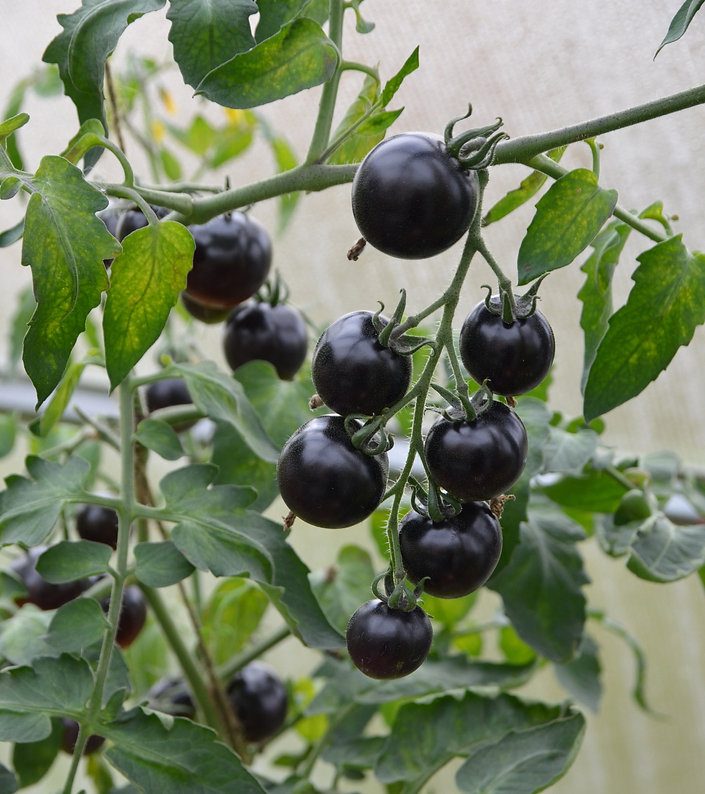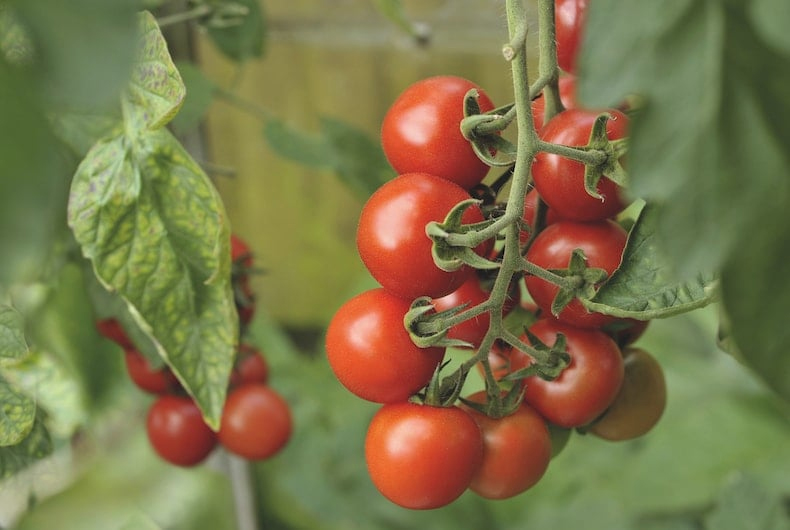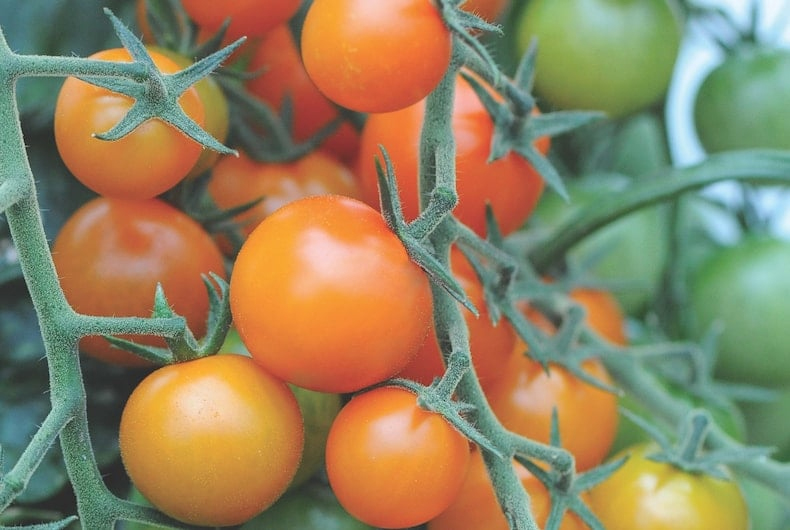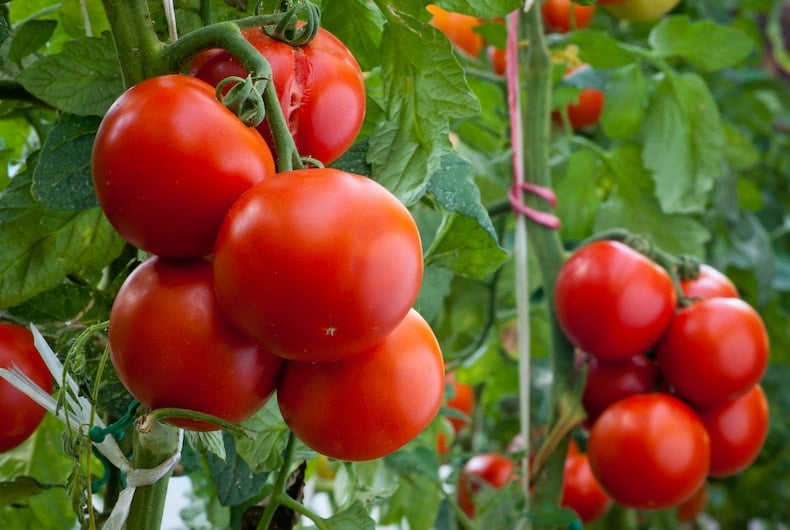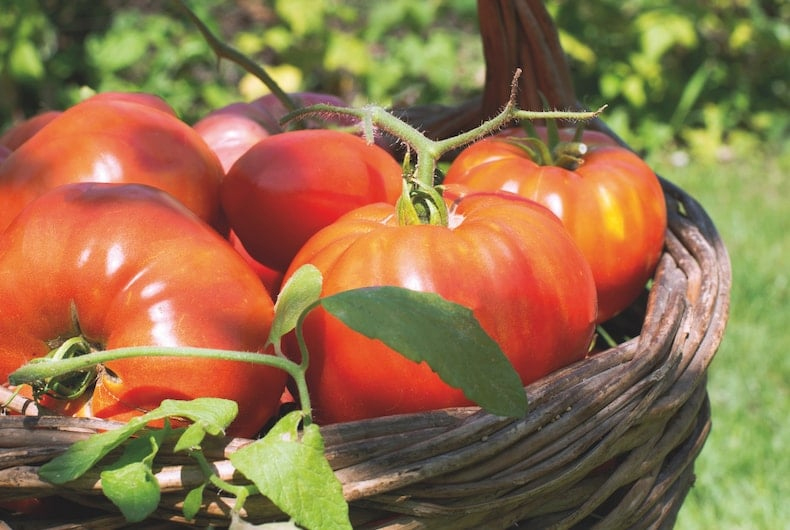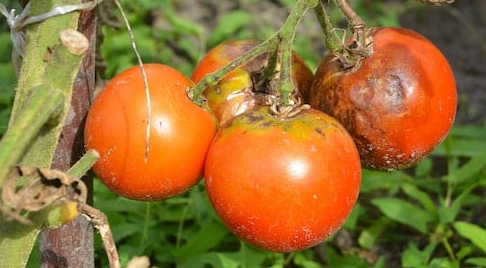Tomato Akoya F1 Hybrid
Tomato Akoya F1 Hybrid
DESCRIPTION
An eye-catching basket or patio container variety, that is sure to create a talking point, these compact plants with attractive purple-dark green foliage produce unusual cocktail-sized fruits ripening gradually from green to black, changing to orange-red when they will be fully ripe and at their best to eat.
Has shown to have good late blight tolerance, ensuring your garden thrives even in challenging conditions. Determinate type

| Height | 18 in | |
| Width | 10 in | |
| Spacing for Seed | Sprinkle on compost cover lightly cover 1/16 in fine compost | |
| Sow Feb to early June | Harvest July to September | |
HOW TO GROW TOMATOES
This page is sponsored by:-
The ultimate guide to growing tomatoes
Tomatoes are an easy, satisfying crop
Image: Tomato ‘Alicante’ from Thompson & Morgan
You can’t beat the taste of sun-warmed tomatoes straight from the vine – and they’re so easy to sow and grow! Growing your own allows you to enjoy special varieties that can’t be bought in a supermarket. That’s because commercial growers need to focus on the disease-resitant cultivars that provide high yields. At home, your tomato crop can be chosen for scent, flavour, size, texture, colour and even lycopene levels. Here are some top tips on how to grow terrific tomatoes.
Sowing
Sow your tomato seeds in March or April, approximately 6-8 weeks before the final frost, or earlier if you’re growing your tomatoes in a greenhouse.
• Sprinkle the seed thinly onto good quality seed compost.
• Cover with 1.5mm of compost and water lightly with a fine-rose watering can.
• Keep the compost moist, but be careful not to over-water as wet conditions can encourage ‘damping-off’ disease, and other mould problems.
• Tomato seeds usually germinate in 7 to 14 days if you maintain a steady temperature of 21 degrees celsius.
• Pot on the tomato seedlings as soon as they’re big enough to handle.
• Hold the plants by the leaves, taking care not to touch the stems, and transplant them into 7.5cm (3in) pots. Protect the plants from frost, cold winds, and draughts which might kill them.
• If you’re only growing a few plants, simply sow two seeds into a couple of 7.5cm (3″) pots and remove the smaller plants as they begin to grow.
How do you grow tomatoes in a glasshouse
Varieties like ‘Sungold’ thrive in greenhouses
Image: Tomato ‘Sungold’ from Thompson & Morgan
Growing tomatoes under glass produces an early crop, especially if you choose recommended varieties like ‘Sungold’, the quick-maturing ‘Shirley’ or the beefsteak ‘Country Taste’. Here are some tips for greenhouse growing:
- Sow your tomato seeds in 7.5cm (3″) pots from February onwards, according to the instructions on the seed packet.
- Plant your young plants when they’re about 15-20cm (6-8in) tall and the flowers of the first truss are just beginning to open.
- If you’re growing in a greenhouse border, make sure you dig in plenty of garden compost or well-rotted manure during the winter, and do remember to rake in a general purpose fertiliser before planting.
- If you’ve used your borders for tomatoes before, change the soil before growing them again or soil pests and root diseases can be a problem.
- Growing tomatoes in pots or a grow bag? Remember they’ll need a lot more water and care.
- Plant your tomatoes about 45cm (18in) apart, leaving 75cm (30in) between rows, and if you’re planting into a grow bag, limit yourself to two plants per bag.
- Tomatoes prefer a temperature of 21 – 24C (70 – 75F) and will perform poorly at temperatures above 27C (81F) or below 16C (61F).
- Make sure you ventilate the greenhouse regularly to deter pests and diseases.
How to grow tomatoes outside
If you don’t have a greenhouse, use tomatoes that are known to flourish outdoors, like ‘Moneymaker’
Image: Tomato ‘Moneymaker’ from Thompson & Morgan
For the best results, choose trusted favourites like ‘Moneymaker’, ‘Gardener’s Delight’, or ‘Alicante’ that are all known to do well outside. Alternatively, if you’re growing your tomatoes in hanging baskets, go for trailing varieties like ‘Tumbling Tom Red’ or ‘Tumbling Bella’. Here are some tips for outdoor growing:
- Wait until approximately 6-8 weeks before the last frost is forecast and sow as directed on the seed packet in 7.5cm (3in) pots.
- Plant out the young vines when they’re about 15-20cm (6-8in) tall, the flowers of the first truss are just beginning to open, and the risk of frost has passed.
- If you’re planting into the ground, make sure you dig in plenty of garden compost or manure during the winter, and just before planting, rake in a general purpose fertiliser. Tomatoes are hungry plants!
- Plant your tomatoes about 45cm (18 in) apart, leaving 75cm (30in) between the rows.
- If you’re using grow bags, limit the number of plants to two, and do remember they’ll need extra watering and care.
- To save space, try growing your outdoor tomatoes in hanging baskets, or upside down. Simply plant a young tomato plant through a hole in the bottom of a bucket or similar hanging container, and fill the container with multi-purpose compost. Suspend the bucket from a bracket and allow the plant to dangle beneath it.
How do you train tomato plants
To ensure healthy tomato growth, training them to rely on a support is crucial
Image: Tomato ‘Crimson Crush’ (Grafted) from Thompson & Morgan
How you train your tomato vines depends on which varieties you’re growing.
- Cordon/indeterminate: The most common tomatoes, these single-stemmed plants grow very tall, sometimes reaching 2.5m. You do need to provide support and remove the side shoots.
- Semi-determinate: Similar to indeterminate varieties (grown as cordons) but producing shorter plants.
- Bush/determinate: These varieties stop growing sooner than cordons with the stem ending in a fruit truss. They’re referred to as ‘bush’ and ‘dwarf’ types, and are suitable for hanging baskets. They don’t require any pruning.
With indeterminate and semi-determinate varieties (cordons), tie the plant to a support as it grows. Pinching out the side shoots as they develop concentrates the plant’s energy into producing fruit. When the cordon reaches the top of its support, cut out the tip of the main stem two leaves above the top flower truss.
For the best quality fruit it’s best to limit the number of fruit trusses to six per plant. If the vine doesn’t reach the top of its support by late summer, cut out the main tip anyway to give the remaining fruits time to ripen.
Determinate varieties (bush/dwarf types) don’t need pruning or training and happily sprawl along the ground or around the pot they’re growing in. Determinate varieties can stop flower production after several trusses, but you can encourage continued upward growth by training up the topmost side shoot.
How much water do tomato plants need?
Tomato plants need a lot of water and feed if they’re to produce a bountiful crop. For best results, water little and often. Some gardeners leave a few filled watering cans to warm in their greenhouse so the water is not shockingly cold from the tap or water butt. There are also those who claim that watering at exactly the same time each day makes a difference to the quality of the fruits.
Feed your tomatoes with a general liquid feed until the first truss has formed then alternate with a high potash feed to encourage more flowers and fruit.
When should you harvest tomatoes?
Harvest tomatoes as they become ripe
Image: Tomato ‘Buffalo Steak’ Grafted from Thompson & Morgan
Start picking your tomatoes as the fruits ripen and gain full colour. When frost threatens at the end of the season, lift any plants with unripe fruit on them and hang them upside down under cover. Tomatoes can be successfully frozen if you find you have a glut.
Common problems with tomato plants
Tomatoes can succumb to several problems, but many of these are caused by growing conditions that can be easily avoided with a little know-how. Be sure that your plants receive the correct amount of warmth, light and water, being careful not to splash the leaves as you water. Here are some of the most common problems and how they can be avoided:
Tomato blight
A common problem caused by wet weather, particularly with outdoor plants, tomato blight spreads fast, leaving telltale brown patches all over the plant. Not only does blight kill vines, it also rots the fruit. How to stop blight? Grow blight resistant tomato varieties or spray Bordeaux Mixture on your plants early in the summer.
Fruit problems
Irregular watering, or too much water too late in the growth cycle causes fruiting problems like:
- Blossom End Rot: Dark patch at the base of the fruit, more common if the plant is grown in a grow bag.
- Blossom Drop: Flower bud falls off.
- Dry Set: Fruitlet growth stops when the fruit is the size of a match head.
- Splitting fruit: Large fissures open up on the fruits as they grow.
Insect pests
Keep a keen eye out for green and white fly because both can spread viruses. Spray your vines with a recommended insecticide as soon as you notice pests. Organic gardeners might prefer to sow marigold seeds nearby which attract beneficial insects that eat pests.
Leaf problems
Curling leaves
May be caused by aphids sucking the sap from them, but if there’s no sign of insects the most likely culprit is cold night-time temperatures (more noticeable in early summer). If this is the case, it’s nothing to worry about.
Mosaic patterns, streaks or distorted leaf surfaces
Your tomatoes may have a virus, in which case your best bet is to remove and destroy them before the problem spreads. Always disinfect tools, boots, and gloves after handling diseased plants.
Leaf yellowing starting on older leaves and moving upwards
The problem could be a magnesium deficiency which is easy to remedy with a special magnesium feed.
Growing tomatoes is such a satisfying way to add homegrown flavour to soups, salads, sandwiches and more. For everything you need to know about growing tomatoes, visit Thompson and Morgan dedicated hub page
CLICK IMAGE
Written by: Sue Sanderson of Thompson and Morgan

